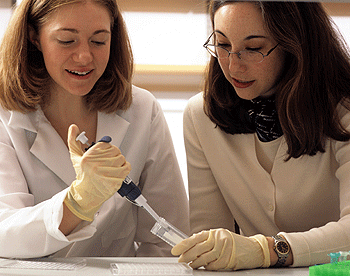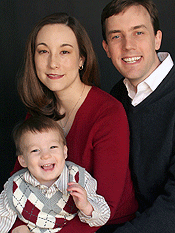As a child growing up in southern California, Shelly Sakiyama-Elbert, Ph.D., assistant professor of biomedical engineering, was fortunate to have some good science teachers beginning in middle school. The teachers designed interesting experiments that were challenging and encouraged problem solving.

“The laboratory experience in high school really turned me on to science and engineering,” says Sakiyama-Elbert, the Joseph and Florence Farrow Assistant Professor of Biomedical Engineering. “I’d always been good in math and science, with chemistry being a favorite, so I thought I might want to be a chemical engineer. The only problem was I didn’t really know what a chemical engineer does when I was in high school.”
Today, after building an international reputation in the field of drug delivery, Sakiyama-Elbert certainly knows what chemical engineering is about. But each fall for the past four years she makes sure that area middle-school students, predominantly girls, know what engineers do.
She and University colleague Ruth J. Okamoto, D.Sc., assistant professor of mechanical and aerospace engineering, offer the course “Moving and Shaking” to some 20 area middle-school students in 90-minute Saturday morning sessions lasting six weeks.
“The program is an introduction to engineering, and I think the kids really enjoy it. It gives a realistic view of what it’s like to be an engineer,” Sakiyama-Elbert says. “Students go to different labs and do hands-on experiments and computer modeling. They interact with undergraduate and graduate students, making it easier to conceptualize what engineers do and easier to picture themselves as an engineer one day.
“I think middle school is the critical age to get students excited about science and engineering. By high school, unfortunately, lots of kids are turned off by math and science.”
Sakiyama-Elbert is the eldest of four siblings (all brothers) and the daughter of Tom and Cathy Sakiyama. Her father, now retired, taught elementary school and eventually trained fellow teachers how to test gifted and/or special-needs students, primarily at the elementary-school level. Her mother also was an elementary-school teacher, in addition to being a homemaker.
“I got very good at standardized tests, given this environment,” she says, smiling. “I must have taken every standardized test known to man.”
She did well enough on her SAT to be admitted to the Massachusetts Institute of Technology in 1992 where, by her sophomore year, she finally grasped what it is that chemical engineers do, thanks to projects that involved nitric oxide kinetics in biological systems and the migration of liver cells on different surfaces.
“I learned a lot about how challenging it is to do research and how you have to work through problems and troubleshoot until you get it right,” she says.
Sakiyama-Elbert graduated in 1996 with a degree in chemical engineering and biology. She started graduate work that fall at the California Institute of Technology under the guidance of adviser Jeffrey Hubbell, Ph.D., professor of chemical engineering, who also advised another student named Donald Elbert, from Lexington, Ky.
Showing Sakiyama-Elbert the laboratory at Cal Tech, Hubbell introduced her to Elbert, and thus began an enduring relationship. Both Shelly and Don later moved to Zurich, Switzerland, with the rest of the Hubbell lab, where she completed the last three years of her graduate studies.
Sakiyama and Elbert married in 1999 — the wedding was in Los Angeles — and both she and her husband applied to various universities for faculty positions that fall, realizing that they might have to take employment at different locales.

Ultimately, weighing multiple offers, Sakiyama-Elbert and her husband chose Washington University.
“It was a good opportunity for us, because we could both be in the same city and both had opportunities for collaboration throughout the University, and it was good for the University because they got two new faculty members for the growing BME department (which expanded by 50 percent with our arrival),” she says. “We’ve actually always worked together in one way or another since we started dating. But, we don’t generally work on the same research projects.
“Still, it’s nice to have someone who knows what you’re going through. We bounce ideas off each other all the time. Sometimes Don knows more about a certain area than I, and I send students over to him to talk to him, or vice versa.”
At Cal Tech, Sakiyama-Elbert developed an approach for delivering drugs to promote nerves and surrounding tissue to regenerate. Think of this system as a kind of scaffold upon which numerous pieces can be attached. The pieces are the drug itself and certain proteins that affect the binding of the drug and its timed release.
“The system is a versatile one,” she says. “One of the key things is designing flexibility so that the system can adapt to new tissue or a new injury model. The essence of the flexibility is the modular nature of the system. We can tune each of the different pieces to the scaffold and make it a little bit more rigid or flexible for the surgeon’s ease of handling.”
The polysaccharide heparin is a vital cog in her system. It provides adhesion sites — or stickiness — for the drugs to bind and take hold at an injury site.
During a college senior project for a course in tissue engineering, Sakiyama-Elbert had two basic options: she could pursue cardiovascular research or the nervous system. Because she had had more exposure to cardiovascular research, she chose the nervous system to learn more.
“The nervous system is amazing,” she says. “It’s fascinating how it forms in development and even after birth. Nature is really elegant in its ability to direct nerves to go over long distances and find the right connections and reinforce those connections. Think of a baby learning to walk — it takes an incredible symphony of nervous communication for that to happen. And we’re just now beginning to get the basic understanding of the biology behind the nervous system.”
Sakiyama-Elbert has recent experience in watching a baby learn how to walk. She and her husband will celebrate son Alex’s second birthday Feb. 23.
She is collaborating with Susan E. Mackinnon, M.D., the Sydney M. Jr. and Robert H. Shoenberg Professor of Surgery and chief of the Division of Plastic and Reconstructive Surgery, in peripheral nerve injury research, the kind found in hands and feet.
She also collaborates with Richard H. Gelberman, M.D., the Fred C. Reynolds Professor, head of the Department of Orthopaedic Surgery and orthopedic surgeon in chief at Barnes-Jewish and St. Louis Children’s hospitals, in regenerating flexor tendons, which are between our fingers.
|
Shelly Sakiyama-Elbert Position: Assistant professor of biomedical engineering Family: Husband, Donald Elbert, Ph.D., assistant professor of biomedical engineering; son, Alex, will be 2 Feb. 23 Research specialty: Drug delivery, regenerative medicine Education: Bachelor’s, chemical engineering and biology, MIT (1996); masters, chemical engineering, Cal Tech (1998); doctorate, chemical engineering, Cal Tech (2000) Major funders: National Institutes of Health, $1.3 million for four years; and Wallace H. Coulter Foundation, $240,000 for two years |
“Dr. Sakiyama-Elbert’s ingenious bioactive system for the sustained delivery of growth factors provides enormous opportunities for advancement in the field of orthopaedic surgery,” Gelberman says. “Together with orthopaedic bioengineers Steve Thomopoulos and Matt Silva, Shelly is exploring clinically relevant applications of prolonged PDGF and bFGF delivery in tendon and ligament repair. The result could be faster and far more complete recovery from disabling hand, shoulder and knee injuries than is currently achievable.
“An ideal collaborator —thoughtful, innovative and challenging, Shelly has helped establish a cross-campus collaboration at Washington University that really works.”
She has been cited by the St. Louis Business Journal in a 2006 summer issue titled “Who’s Who in Technology,” and earlier by that publication was highlighted as one of “30 Under 30” talented researchers in St. Louis.
Sakiyama-Elbert’s expertise — reflecting three degrees — stacks up heavily on the chemical engineering side. To keep up with the dynamic nature of biology, she attends seminars and conferences and reads the literature all the time.
“In trying to do regenerative medicine or tissue engineering, I think we really have to look at developmental biology to understand the critical cues that are there when a tissue is generated the first time,” she says.
She and her collaborators have achieved success in cell culture studies with her system and are now doing preclinical studies, with human studies “still several years away,” she says.
“I’m happy to be doing regenerative medicine with some of the world’s best researchers and designing materials that can interact in the body and sense cues from cells to help direct tissue regeneration,” she says. “As we start to understand the biology at a molecular level, we can put just the right cues into the materials, keeping in mind that the more that the body can do itself, the better.”